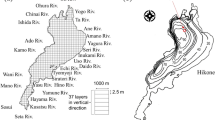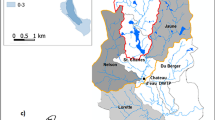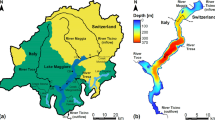Abstract
A deterministic, one-dimensional, unsteady numerical model has been developed, tested, and applied to simulate mean daily dissolved oxygen (DO) characteristics in 27 lake classes in the state of Minnesota. Reaeration and photosynthesis are the oxygen sources, while respiration, sedimentary, and biochemical water column oxygen demand are the sinks of oxygen in the model. The lake classes are differentiated by surface area (A s), maximum depth (H max), and trophic status expressed as Secchi depth (Z s). Because lake stratification is most important to lake oxygen dynamics, simulated DO characteristics are plotted in terms of a stratification parameterA s/H 0.25max and Secchi depthZ s. Simulations provide DO profiles on a daily time scale. Specific DO characteristics of ecological and environmental interest are epilimnetic DO, hypolimnetic DO, DO gradient from surface to bottom, and DO minima and maxima. Specific results are as follows: Simulated mean daily and weekly DO values in the epilimnion of all lakes for both past and future climate scenarios are near saturation over the summer season. Hypolimnetic DO values depend strongly on lake morphometry, trophic status, and time throughout the summer season. Future climate conditions are specified as the historical records from 1955 to 1979, adjusted (monthly) by the 2 × CO2 GISS model output to account for doubling of atmospheric CO2. With this climate change, weekly averaged epilimnetic DO is projected to drop by less than 2 mg/liter, and will remain above 7 mg/liter throughout the open water season. The hypolimnetic DO reductions after climate change are on the order of 2–8 mg/liter. Periods of anoxia are longer by as much as 80 days. Those changes would alter water quality dynamics in lakes and have a profound effect on lake ecosystems including indigenous fishes. The results presented are useful for evaluating environmental management options.
Similar content being viewed by others
Literature Cited
Ambrose, R. B., T. A. Wool, J. P. Connolly, and R. W. Schanz. 1988. WASP4 (EUTRO4), A hydrodynamic and water quality model—model theory, user's manual, and programmer's guide. US Environmental Protection Agency, Athens, Georgia, EPA/600/3-87/039.
Baker, D. G., E. L. Kuehnast, and J. A. Zandlo. 1985. Climate of Minnesota Part 15—Normal temperatures (1951–1980) and their application. Agricultural Experiment Station, University of Minnesota. AD-SB-2777.
Blumberg, A. F., and D. M. Di Toro. 1990. Effects of climate warming on dissolved oxygen concentrations in Lake Erie.Transactions of the American Fisheries Society 119(2):210–223.
Brown, L. C., and T. O. Barnwell, Jr. 1987. The enhanced stream water quality models QUAL2E and QUAL2E-UN-CAS: Documentation and user manual. US Environmental Protection Agency, Athens, Georgia. EPA-600/3-87/007.
Carlson, R. E. 1977. A trophic state index for lakes.Limnology and Oceanography 22:361–369.
Chang, L. H., S. F. Railsback, and R. T. Brown. 1992. Use of reservoir water quality model to simulate global climate change effects on fish habitat.Climatic Change 20:277–296.
Coutant, C. C. 1985. Striped bass, temperature, and dissolved oxygen: A speculative hypothesis for environmental risk.Transactions of the American Fisheries Society 114:31–61.
Dobson, H. F. H., M. Gilbertson, and P. G. Sly. 1974. A summary and comparison of nutrients and related water quality in Lake Erie, Ontario, Huron, and Superior.Journal of the Fisheries Research Board of Canada 31:731–738.
ERLD/MNDNR. 1990. Minnesota Department of Natural Resources, Fisheries Division Lake Data Base. Expanded by US Environmental Protection Agency Environmental Research Laboratory, Duluth, Minnesota.
Goldman, C. R., and A. J. Horne. 1983. Limnology. McGraw-Hill, New York.
Gorham, E., and F. M. Boyce. 1989. Influence of lake surface area and depth upon thermal stratification and the depth of the summer thermocline.Journal of Great Lakes Research 15(2):233–245.
Hansen, J., G. Russell, D. Rind, P. Stone, A. Lacis, S. Lebedeff, R. Ruedy, and L. Travis. 1983. Efficient three-dimensional global models for climate studies: models I and II.Monthly Weather Review 3(4):609–662.
Heiskary, S. A., and C. B. Wilson. 1988. Minnesota lake water quality assessment report. Minnesota Pollution Control Agency, St. Paul, 49 pp.
Heiskary, S. A., C. B. Wilson, and D. P. Larsen. 1987. Analysis of regional patterns in lake water quality: using ecoregions for lake management in Minnesota.Lake and Reservoir Management 7:337–344.
Hondzo, M., and H. G. Stefan. 1992. Water temperature characteristics of lakes subjected to climate change. Project report No. 329. St Anthony Falls Hydraulic Laboratory, University of Minnesota, 166 pp.
Hondzo, M., and H. G. Stefan. 1993. Regional water temperature characteristics of lakes subjected to climate changes.Climatic Change (in press).
Hutchinson, G. E. 1957. A treatise on limnology, Vol. 2. Wiley, New York.
Lathrop, R. C., and R. A. Lillie. 1980. Thermal stratification of Wisconsin lakes.Journal of the Wisconsin Academy of Science 68:90–96.
Marshall, C. T., and R. H. Peters. 1989. General patterns in the seasonal development of chlorophyll-a for temperate lakes.Limnology and Oceanography 34(5):856–867.
NAS (National Academy of Science and National Academy of Engineering). 1973. Water quality criteria 1972—a report of the committee on water quality criteria. EPA-R3-73-033, Washington, DC.
Omernik, J. H. 1987. Ecoregions of the conterminous United States.Annals of the Association American Geography 77(1):118–125.
Osgood, R. A. 1984. A 1984 study of the water quality of 43 metroplitan area lakes. Publication No. 10-84-172, Metropolitan Council of the Twin Cities Area, St. Paul, Minnesota.
Osgood, R. A. 1985. A 1985 study of the water quality of 32 metropolitan area lakes. Publication No. 10-85-156, Metropolitan Council of the Twin Cities Area, St. Paul, Minnesota.
Rast, W., and G. F. Lee. 1978. Summary analysis of the North American (U.S. portion) OECD eutrophication project: Nutrient loading—lake response relationships and trophic indices. USEPA, Corvallis Environmental Research Laboratory, Corvallis, Oregon. EPA-600/3-78-008, 454 pp.
Riley, M. J. 1988. User's manual for the dynamic lake water quality simulation model MINLAKE. External memorandum No. 213. St Anthony Falls Hydraulic Laboratory, University of Minnesota, Minneapolis, Minnesota.
Sakomoto, M. 1966. Primary production by photoplankton community in some Japanese lakes and its independence on lake depth.Archiv für Hydrobiologie 62:1–28.
Stefan, H. G., and X. Fang. 1993. Dissolved oxygen model for regional lake analysis.Ecological Modeling (in press); also available as External memorandum No. M-232. St. Anthony Falls Hydraulic Laboratory, University of Minnesota, Minneapolis, MN, 55414.
Stefan, H., M. Hondzo, B. Sinokrot, X. Fang, J. G. Eaton, B. Goodno, K. Hokanson, J. McCormick, D. O'Brien, and J. Wisniewski. 1992. A methodology to estimate global climate change impact on lake and stream environmental conditions and fishery resources with application to Minnesota. Project report No. 323, 2nd ed. St Anthony Falls Hydraulic Laboratory, University of Minnesota, 141 pp.
Stumm, W., and Morgan, J. J. 1981. Aquatic chemistry. Wiley-Interscience, New York.
Taub, F. B. 1984. Ecosystem processes. Pages 1–42in F. B. Taub. Lakes and reservoirs. Elsevier Science Publishers, Amsterdam, The Netherlands.
Thomann, R. V., and J. A. Mueller. 1987. Principles of surface water quality modeling and control. Harper & Row, New York, 644 pp.
USEPA (US Environmental Protection Agency). 1974. The relationships of phosphorus and nitrogen to the trophic state of northeast and north-central lakes and reservoirs. National Eutrophication Survey Working Paper No. 23, US EPA, Pacific Northwest Environmental Research Laboratory, Corvallis, Oregon, 28 pp.
USEPA (US Environmental Protection Agency). 1985. Ambient water quality criterion for dissolved oxygen: freshwater aquatic life.Federal Register 50:15634–15668.
USEPA (US Environmental Protection Agency). 1988. The potential effects of global climate change on the United States. US Environmental Protection Agency, Report to Congress, Washington, DC.
Wetzel, R. G. 1983. Limnology. W. B. Saunders Company, Philadelphia, Pennsylvania, 743 pp.
Zison, S. W., W. B. Mills, D. Diemer, and C. W. Chen. 1978. Rates, constants and kinetic formulations in surface water quality modeling. Tetra Tech, Inc. for USEPA, ORD, Athens, Georgia. EPA 600-3-78-105, 317 pp.
Author information
Authors and Affiliations
Rights and permissions
About this article
Cite this article
Stefan, H.G., Fang, X. Model simulations of dissolved oxygen characteristics of Minnesota lakes: Past and future. Environmental Management 18, 73–92 (1994). https://doi.org/10.1007/BF02393751
Issue Date:
DOI: https://doi.org/10.1007/BF02393751




